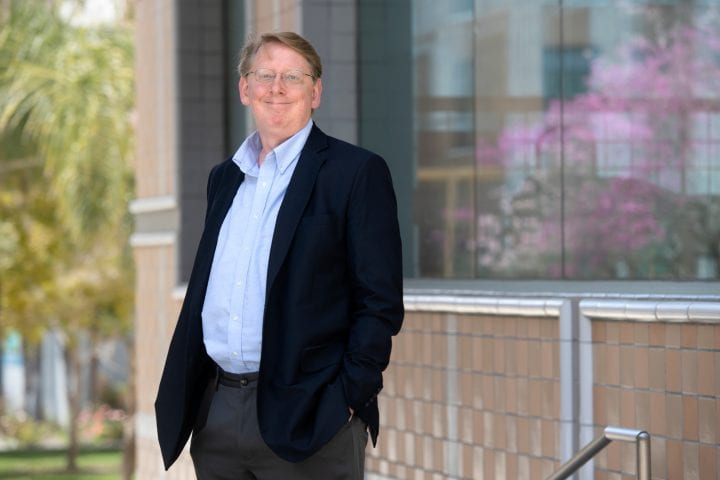UC Irvine-led team of researchers uncovers battery-like functions of mitochondria
First-of-their-kind findings made possible by new generation of powerful microscopes

Irvine, Calif., Nov. 27, 2023 – Using new super-resolution microscopes, researchers at the University of California, Irvine and the University of Pennsylvania have for the first time observed electrical charge and discharge functions inside mitochondria isolated from cells.
A mitochondrion is a structure within a cell that uses aerobic respiration to generate adenosine triphosphate, an organic compound that provides energy to support many processes in living tissues. Medical and biomedical engineering researchers have sought greater understanding of mitochondria, recognizing their importance in human health and disease.
While many past research projects have studied the physical characteristics of these components as they exist within living cells, the UCI-led project is the first to use super-resolution microscopes to study live, extracellular mitochondria. By observing the changes in the mitochondrial membranes under different metabolic states this way, the researchers were able to witness the electrophysiological functioning of these living organelles. The team’s results were published in the journal ACS Nano.
“When we first started studying isolated mitochondria, we knew they behaved like a battery based on some work from the Tokyo Metropolitan Institute of Gerontology and UCLA, but we could not control them very well inside the cell to probe them,” said co-author Peter Burke, UCI professor of electrical engineering and computer science. “Now we can control each individual electrical component and cause it to charge and discharge.”
He said the work was made possible by a new generation of super-resolution microscopes. Team members used all three leading methods – Airy microscopy, stimulated emission depletion microscopy and lattice structured illumination microscopy – in their study.
This enabled them to examine cristae, repeating serpentine structures within mitochondria that measure about 100 nanometers. The shortest wavelength of visible light is violet at about 380 nanometers, Burke said, so they needed powerful instruments – super-resolution microscopes – to probe the voltage distribution of something less than a third of that size.
“Imagine trying to study how the battery pack in a Tesla works, but you can only do it by driving the car,” he said. “You would not learn much about the battery pack inside the car.”
By taking mitochondria out of the cell and keeping them alive, Burke and his collaborators –
lead author ChiaHung Lee, UCI graduate student researcher in biomedical engineering, and Douglas Wallace of the University of Pennsylvania – were able to charge and discharge them.
“We could observe in detail how each individual part behaved as a single battery, much like how battery packs in drones and cars – which are many smaller batteries – individually combine to power the vehicle,” Burke said. “Interestingly, we found that the batteries rearrange themselves when they charge and discharge, a feature not found in regular batteries.”
He noted that his experiments proved what researchers had long thought while studying snapshots of frozen (dead) mitochondria: The internal structure changes in response to the metabolic needs of the cell. A mitochondrion can create and destroy its “batteries” (cristae) as needed. This shows that, unlike drones and Teslas, mitochondria can alter their internal shapes based on how much energy is needed by cells.
Burke said this work could have broad applications in human health, including studies on how humans age at the cellular level.
“Once we understand how they create energy, we can start to think of ways to modify this for improving human health and longevity,” he said.
The project was funded by the National Institutes of Health and the Army Research Office.
About UCI’s Brilliant Future campaign: Publicly launched on Oct. 4, 2019, the Brilliant Future campaign aims to raise awareness and support for UCI. By engaging 75,000 alumni and garnering $2 billion in philanthropic investment, UCI seeks to reach new heights of excellence in student success, health and wellness, research and more. The Henry Samueli School of Engineering plays a vital role in the success of the campaign. Learn more by visiting https://brilliantfuture.uci.edu/the-henry-samueli-school-of-engineering.
About the University of California, Irvine: Founded in 1965, UCI is a member of the prestigious Association of American Universities and is ranked among the nation’s top 10 public universities by U.S. News & World Report. The campus has produced five Nobel laureates and is known for its academic achievement, premier research, innovation and anteater mascot. Led by Chancellor Howard Gillman, UCI has more than 36,000 students and offers 224 degree programs. It’s located in one of the world’s safest and most economically vibrant communities and is Orange County’s second-largest employer, contributing $7 billion annually to the local economy and $8 billion statewide. For more on UCI, visit www.uci.edu.
Media access: Radio programs/stations may, for a fee, use an on-campus ISDN line to interview UCI faculty and experts, subject to availability and university approval. For more UCI news, visit news.uci.edu. Additional resources for journalists may be found at communications.uci.edu/for-journalists.